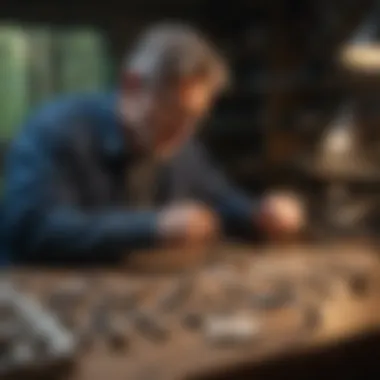Understanding Fossils: Exploring Their Origins and Significance


Intro
Fossils serve as remnants from a distant past, providing vital clues about the Earth's history and the life forms that inhabited it. Exploring fossils goes far beyond mere curiosity; it offers insights into how life evolved, how ecosystems functioned, and how the planet has changed over millions of years. Understanding fossils enhances knowledge in geology, biology, and environmental science. It pinpoints misconceptions and promotes informed discussions. This exploration into fossils is set against the backdrop of climate change, offering a vital perspective on biodiversity and our current environmental challenges.
In this section, we will examine the types of fossils, their origins, and their role in shaping our understanding of the planet. The quest for fossil discovery combines advances in dating techniques and technological innovation, facilitating the uncovering of long-buried history.
Moreover, this thorough investigation also considers fossil implications for contemporary science. Ultimately, engaging with fossils enriches our grasp of natural history and allows for predictions of potential future changes in our environment.
This exploration into fossils is as much an inquiry into our past as it is an examination of how these ancient forms of life can enlighten our present and future.
In the sections that follow, we will break down the significance of different types of fossils, outline methodologies for fossil analysis, and engage in discussions surrounding the implications of fossil findings for the broader fields of climate science and biodiversity. Through this, we aim to elucidate the indispensable role fossils hold in contemporary science.
Defining Fossils
Defining fossils is a fundamental aspect of paleontology and geology. Understanding what constitutes a fossil allows scientists to categorize and interpret ancient biological records effectively. Fossils offer insights not only about past life forms but also about the environments in which these organisms lived. Furthermore, a precise definition of fossils creates clarity, enabling collaboration across diverse scientific disciplines.
What Constitutes a Fossil?
A fossil is typically any preserved remain, impression, or trace of a once-living organism. This includes bones, shells, and plants. Generally speaking, to qualify as a fossil, the specimen must be older than 10,000 years, although older elements lose direct ties to specific organisms. The process commonly involved for such preservation can vary significantly, leading to various fossil forms.
Key points regarding fossils:
- Body fossils include actual remnants of organisms, such as bones and teeth.
- Trace fossils are indirect evidence of life, like footprints or burrows, indicating behaviors instead of direct remains.
Understanding the different facets of fossils establishes a crucial basis for exploring how life has evolved through time. This forms the backbone of paleontological studies and enriches our understanding of ecological changes over geological periods.
The Importance of Fossils in Science
Fossils are indispensable in reconstructing Earth’s biological history. Through fossil evidence, scientists can piece together the timeline of life, illustrating how species have changed or disappeared over millions of years. They play a vital role in various scientific disciplines, including biology, geology, and meteorology.
Fossils bridge the gap between past and present, shedding light on evolutionary processes and extinct life.
Benefits of Using Fossils in Study:
- Climatology: Fossils can reflect historical climate conditions, contributing to climate change discussions today.
- Biodiversity Studies: Understanding past biodiversity patterns helps gauge current ecological trends and threats.
- Biogeography: They assist in tracking how different species migrated and adapted over time.
Recognizing their importance fosters a more profound appreciation for not only fossils but also Earth’s intricate history—and ultimately our place within it. Connecting fossils to modern issues provides invaluable context for both scientific inquiry and public understanding.
The Process of Fossilization
The study of fossils does not only revolve around their existence in sedimentary rocks, but the process by which they are formed is equally important. Understanding fossilization provides insight into environmental conditions and biological evolution over extensive periods. This analysis bears significant relevance in understanding how life on Earth has adapted through time. The complexity of fossilization yields a number of considerations that underscore its critical role in paleontology and geology.
Conditions for Fossilization
Successful fossilization is dependent on a myriad of environmental conditions. Not every organism will become a fossil; geological factors play an essential function in this intricate process. The presence of suitable sediments at the time of an organism's death is a primary condition. Groundwater does also contribute by creating a stable environment where organic debris can undergo compaction and preservation.
Another essential condition is anaerobic bacteria, which help in exceptional preservation. They slow down the decaying process.


To summarize key factors that can improve the chance of fossilization:
- Rapid burial by sediments
- Reduced exposure to oxygen
- Lower temperatures
These compose the conditions that increase the likelihood of a specimen becoming a fossil. Understanding these parameters enhances our grasp of previous ecosystems.
Types of Fossilization
Several types of fossilization exist, each yielding different forms and types of preserved evidence of past life. The diversity within the processes of fossilization reveals the varied ways in which organisms became embedded in geological records. Each type provides unique insight into the prehistoric environment.
Permineralization
Permineralization represents a significant method whereby microscopic minerals infill the empty spaces in organic material. For example, tree trunks or bones can undergo this type of fossilization. The key characteristic of this process is that it retains original cellular structure. This contributes greatly to our ability to investigate ancient plants and animals, making it ideal for researchers. It preserves delicate details, such as growth rings and even bone formation.
Advantages of permineralization include achieving high fossil fidelity and robustness. The downside might be the conditions necessary for this type sometimes being hard to replicate.
Molds and Casts
The molds and casts develop when an organism leaves an imprint in a substrate, creating a mold. Following this, when the mold fills in with sediments or minerals, a cast forms. What makes this process particularly advantageous? The preservation of an organism's external shape. These molds and casts can be found frequently, providing evidence from soft-bodied fossils which can be otherwise rarely found. Thus, they add considerably to our lens of understanding prehistoric sediment and life.
The unique feature of molds and casts is the potential for high detail, albeit without internal structures. Collaboration of both can enrich paleontological records. The downside may include distortion in the shape due to the surrounding sediment settling unevenly during formation.
Amber Preservation
Amber preservation involves the entrapment of organisms in tree resin, hardened over millions of years into amber. This type of fossilization is remarkable for its ability to capture minute details, such as hair and soft-bodied invertebrates. The distinctive aspect of amber is its transparency and preserved organic structure, which makes it a fascinating source for paleontologists.
However, being limited primarily to small organisms is an acknowledged constraint. As such, while it contributes valuable, detailed insights into specific species, it does not provide a comprehensive view of prehistoric ecosystems as a whole.
Amber fossils represent a significant treasure trove of insights into biodiversity, climate, and environmental interactions during the formative years of our planet.
Classifications of Fossils
Classifying fossils is essential for various scientific disciplines, including paleontology, geology, and archeology. It allows for a clearer understanding of the biological evolution of life forms, as well as the environmental conditions that existed in different geological periods. By categorizing fossils, scientists can investigate and simplify a vast array of paleontological data, facilitating improved research and exploration.
Body Fossils vs.
Trace Fossils
Fossils are primarily classified into two categories: body fossils and trace fossils.
Body fossils are tangible remnants of the actual organisms that once lived, such as bones, teeth, shells, and leaves. These items represent physical aspects and offer insights into shape, size, and structure of the creatures. In contrast, trace fossils are indirect evidence of past life. They include footprints, burrows, and feces that indicate the behavior and interactions of organisms. Both categories deliver unique information about primatial habitats and behavioral patterns.
Understanding the distinctions in these fossil types enhances our approaches toward studying ancient ecosystems. Scientists often depend on these classifications to uncover ecological dynamics and evolutionary transitions throughout Earth’s history. For example, trace fossils can reveal activity patterns like feeding strategies or social structures of extinct species.
Without studying body and trace fossils, reconstructing life's myriad forms and their ecological interactions would be near impossible.
Microfossils and Macrofossils


Another dimension within fossil classification is the dichotomy between microfossils and macrofossils. Microfossils are usually under one millimeter in size and consist of microorganisms, such as pollen, diatoms, and foraminifera. Despite their minute dimensions, these fossils can provide significant insights into past environmental conditions, trends in climate, and even aid in oil discovery.
On the other hand, macrofossils are larger and include bones, shells, and leaves that can be seen without a microscope. These fossils offer information about larger entities of ecosystems such as flora and fauna interaction, biodiversity levels, and evolutionary occurrences. The categorization into micro and macro enhances the breadth of research methodologies and informs different approaches suited to the scale of study.
The Role of Fossils in Geological Time
Fossils are critical in the study of geological time as they provide essential clues about the evolution of life on Earth. The identification and analysis of fossils allow scientists to shape a chronology of lifeforms, facilitating an understanding of their distribution, adaptation, and extinction throughout various periods. In essence, fossils serve as a timeline that discern the increment of changes in the planet’s biosphere, thus highlighting significant events in geological history. This aspect makes fossils indispensable in paleontology and geology, revealing patterns applicable in various scientific fields, including climate science and conservation.
Understanding Stratigraphy
Stratigraphy involves the study of rock layers, known as strata, and their relationship to geological time. The presence of fossils within these strata avails vital data regarding the environmental conditions predominant at specific intervals in Earth’s history. For instance, a layer rich with marine fossils indicates a prior existence of ocean environments.
Stratigraphic correlations lend credibility to the processes of geological dating, affording a framework within which sediments and fossils are organized. This methodology reveals the sequential nature of life on Earth, aligning certain species or groups with specific periods, commonly referred to as biostratigraphy. This affords researchers a platform for investigating evolutionary lineages and contextualizing them within broad geological timeframes.
Dating Fossils: Techniques and Methods
Dating fossils is fundamental in understanding their age and the geological epochs they belong to. There are two main types of dating methods applied in fossil studies: relative dating and radiometric dating.
Relative Dating
Relative dating encompasses identifying the sequences of past events without providing a specific numerical age. This method operates on the principle of superposition, where the oldest layers are usually at the bottom and the more recent strata are above. Relative dating is a popular choice due to its straightforwardness.
- Key Characteristic: It establishes a sequence, showing which fossils are older or younger compared to others.
- Unique Feature: It often uses index fossils, which are widespread and existed for a limited time, acting as markers for corresponding ages of rock layers.
- Advantages: Relative dating is schnelle and cost-effective, requiring only access to survey fossils and rock layers to build a relative timeline of lifeforms.
- Disadvantages: It lacks the precision and cannot provide exact age, rendering it less applicable in terms of determining specific environmental changes over time.
Radiometric Dating
Radiometric dating is a technique employed to determine the absolute age of fossils by measuring the decay of radioactive isotopes present in surrounding rocks or in the fossils themselves, such as uranium-lead or carbon-14 methods.
- Key Characteristic: This process involves assigning numerical ages to fossils based on isotopic decay rates.
- Unique Feature: Its capability to offer precise dating is crucial when fitting fossils within a narrower geological framework, significantly influencing interpretations of evolutionary changes.
- Advantages: Radiometric dating allows for accurate and quantifiable results, leading to clear chronologies that assist in understanding life’s progression through epochs.
- Disadvantages: The requirement of suitable materials for testing limits usage; certain fossils or sediments may not contain radioisotopes conducive to this method, affecting dating outcomes.
In summary, investigating fossils through understanding stratigraphy and employing both relative and radiometric dating is fundamental for exploiting their historical value in geological studies. This knowledge further indicates climatic patterns, ecological shifts, and the adaptive strategies of numerous species over time.
Fossils and Paleontology
Paleontology, the study of fossils, bridges the gap between biology and geology, intertwining them in a tapestry rich with historical significance. Fossils provide crucial insights into Earth's evolution over millions of years. Their study reveals not just the existence of ancient organisms, but their behaviors, environmental adaptations, and evolutionary relationships. This context is vital for understanding the planet's biological history and grasping the processes that led to modern biodiversity.
The Study of Fossils
The examination of fossils forms the backbone of paleontological research. Fossils can be studied in various contexts, including stratigraphy, sedimentology, and sequence stratigraphy. Knowledge of fossil morphology, distribution, and associations strengthens the understanding of evolutionary processes. Paleontologists often utilize advanced techniques such as:
- Morphometric analysis to quantify and compare shapes of fossils.
- Geochemical analysis to interpret past environments where the organisms thrived.
- Comparative anatomy which helps in establishing phylogenetic relationships among different species.
By identifying species, stratigraphic ranges, and associated fossils, researchers can trace the progress of life forms across geological time. This contributes to not only Indiana historical biogeography but also a better appreciation for contemporary biodiversity. Fossils serve as timeless records of life on Earth.
Fossils as Indicators of Past Life
One of the most significant functions of fossils is to provide evidence of past life forms and ecological conditions. They act like clues, each fossil a piece within a larger puzzle of Earth’s history.


The indicators of past life include:
- Body Fossils: remnants of the organisms themselves, such as bones or shells.
- Trace Fossils: tracks, burrows, or fossilized behavior that denote the activities or movements of living organisms.
Fossils not only inform about the species that once populated the planet but also about their environments. For instance, the discovery of certain marine fossils in what is now dry land tells us about historical sea levels and climate changes.
Fossils hold a mirror reflecting not just what was, but how ecosystems transformed under shifting climates through the eons.
In addition, fossils can indicate shifts in inhabitants’ diversity which correlates with mass extinctions and subsequent recoveries of life. Such insights enhance professionals’ and academics’ perspectives on environmental changes. These historical clues are increasingly relevant in current discussions regarding biodiversity and conservation efforts amidst ongoing climate variations.
Fossils in the Context of Climate Change
Fossils serve as vital records that map Earth's climatic fluctuations over millions of years. Their study sheds light on how past environments responded to natural changes, which in turn informs our current understanding of climate dynamics. Annalyzing fossils provides clear, empirical data that connects biodiversity and climate conditions. This exploration into fossils not only enriches the scientific discourse but also has profound implications in modern policy-making regarding climate action.
Fossil Evidence of Past Climates
Fossil records offer critical indicators of conditions in previous eras. Climate proxies can be evaluated in various formats, including isotopic analysis and fossilized flora and fauna.
- Isotopic Data: The ratios of certain isotopes in sedimentary rocks can reveal temperature variations. For example, oxygen isotopes can indicate the temperature of ancient oceans.
- Fossilized Plants: Changes in plant types and their distributions can reflect climatic shifts. For example, evidence of larger tree species may suggest warm climates, while smaller, drought-resistant flora may indicate arid conditions.
- Marine Fossils: The presence of certain marine species often signals climate types. Coral reefs thrive in warm waters, thus affected by certaain climatic conditions inspired. Examining where specific corals grew helps reconstruct ancient temperatures.
Through rigorous assessment of these fossil records, scientists can generate climate narratives that span epochs. These storrides enable predictions about refugia and extinctions, shaping how we navigate today's challenges in biodiversity loss.
Implications for Modern Climate Conversations
The relevance of fossil studies cannot be understated in current climate debates. As global temperatures rise, drawing lessons from ancient climates helps frame responses to contemporary issues.
- Historical Context: Understanding past extinctions linked to climate can inspire precautionary measures today. As temperatures rise, certain species may no longer adapt quickly. The fossil record showcases the time it took for ecosystems to rebalance post-extinction events.
- Ecosystem Resilience: The fossil evidence explains how ecosystems expelled under climatic duress can recover effectively, if given time and proper conditions. This information is invaluable in biodeversity discussions. Developments and mitigation transkofîng prioritize ecosystem health as a buffer.
- Policy and Management: Policymakers can effectively utilize fossil evidence in formulating strategies. Recognizing past resiliency may challenge perceptions that ecosystems are static. Instead, fossil insights highlight vulnerabilities and adaptability.
In summary, utilising fossils as references for climates shifts helps enrich discussions about environmental caring. As both a tool for introspection and foresight, fossils create a tapestry of knowledge upon which future strategies can be constructed.
The Future of Fossil Studies
The field of fossil studies carries great importance for science and history. As we advance into the future, the methodologies and considerations surrounding the research of fossils continue to develop. The future of fossil studies is marked by exciting technological innovations and critical ethical discussions. Understanding these aspects can enhance not only scientific inquiry but also public interest and awareness regarding our planet's history.
Technological Advances in Fossil Research
Recent technological advances provide tools that transform the study of fossils. One such innovation involves high-resolution imaging techniques, like CT scanning and 3D modeling. These methods enable researchers to visualize and analyze fossil structures with greater precision, revealing details previously hidden from view. Not only do these techniques facilitate the examination of fossil integrity, but they also uncover the microstructures within fossils that provide clues about the biology of extinct organisms.
Another significant advancement is the use of isotopic analysis. This allows scientists to determine the environmental conditions of the time when the organism lived. By studying the isotopic composition of fossils, paleontologists can gain insights into ancient climates and ecosystems, enhancing our understanding of how life evolved in different environments.
The interest in biogeochemistry is increasing as well. The utilization of geochemical methods offers data on the behaviors and conditions that prevailed on Earth millions of years ago.
Through the application of machine learning algorithms, fossil classification is witnessing enhancement. With vast amounts of data becoming available, these algorithms can identify patterns and predict evolutionary links between species, potentially uncovering new connections that are significant in evolutionary biology.
The Ethical Considerations of Fossil Collection
Ethical considerations in fossil collection have gained importance in recent years, necessitating discussions on how fossils are gathered and curated. Fossils are not merely artifacts; they represent the history of life on Earth. Collecting them involves responsibilities that researchers and institutions must not overlook.
One central ethical issue is the proper treatment of fossils. Ensuring that fossils are not destroyed or improperly displayed is paramount. Conditions should guarantee the preservation of the specimens in controlled environments.
Another aspect relates to the legality and legitimacy of collecting fossils. Fossils should only be legally obtained, adhering to guidelines established by countries, which protect heritage and fossil resources. Countries like China and Mongolia have strict regulations regarding fossil collection to prevent black market trafficking of valuable specimens.
Public sentiment also plays a role in fossil collection ethics. Researchers are ideally engaged with communities to educate them about the significance of fossils. Building strong relationships can inspire local stewardship of fossil resources.
Engaging local communities in fossil preservation can enrich both scientific research and public understanding of paleontology.



